Alfred Hair

The Driving Force Behind the Highwaymen
BY CATHERINE ENNS GRIGAS
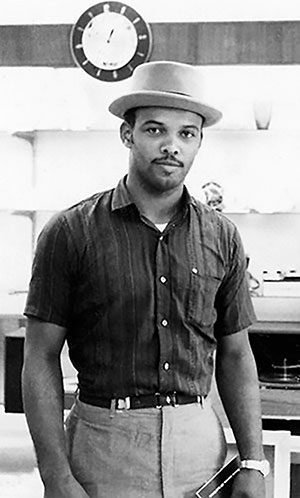
It has been nearly 50 years since a young black man was shot and later died on a hot August night in a modest little bar on Avenue D in Fort Pierce. He might have been forgotten, except that he left a curious legacy that was to live on long after his death.
Alfred Hair was an artist, and his paintings of turquoise seas, peach clouds and scarlet royal poinciana trees, along with the thousands more created by his friends, family, neighbors and acquaintances, became the signature works of the 26 African-American artists who were later called the Florida Highwaymen.
Hair’s death at age 29 on Aug. 9, 1970, shook the community of Fort Pierce. The following day, the front page of The News Tribune was emblazoned with a headline that read, “Shot Down in Fort Pierce: Well Known Artist Alfred Hair Slain.”
Accounts of what happened the night he died varied. The newspaper’s story of the event, which took place at a popular hangout called Eddie’s Place (also known as Eddie’s Drive Inn), stated that a migrant grove worker named Julius Funderburk “hit a man named Castro Roberts, then hit Hair. Hair reportedly ran out of the building, police said, and Funderburk chased him into the street and shot him ... Hair apparently died of two gunshot wounds.” Funderburk was later convicted of second-degree murder and served five years in prison.
When word got out that fateful evening that Hair had been shot, hundreds of people gathered at Fort Pierce Memorial Hospital on North Seventh Street.
His widow, Doretha Hair Truesdell, remembers that she grabbed her keys and ran out the door heading to the hospital when she got the phone call that her husband had been shot.
“I turned off Dunbar onto 29th Street speeding, and then I knew,” she recalls. “I slowed down, there was no need to speed because he was gone. I felt it… When I reached the hospital and waded through the crowd to the entrance to the emergency room I was told he didn’t make it… Life as I knew it was gone. That man who would give you his last was gone. The art life was over.”
Thousands attended his funeral. Loudspeakers were put outside so the people who could not fit in could listen to the service. He was laid to rest under a simple marker at Pine Grove Cemetery.
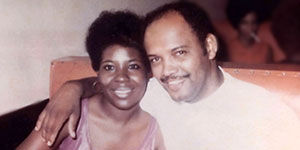
Immediately following his death, Hair’s teacher and mentor, the pre-eminent Florida landscape artist A.E. (Bean) Backus was so concerned about the welfare of the family left behind that he held a sale at his studio of Hair’s paintings — finished and unfinished — to raise money for Doretha, a school teacher, and their four children, Alfred Jr., Sherry, Roderick and Lisa.
But it was not only family Hair left behind. He was the pivotal figure in a car-centric enterprise he had created and orchestrated to practically flood Florida with original oil paintings of the Florida landscape by selling them door to door.
“Driving Force: Alfred Hair and the Florida Highwaymen,” an exhibition at the Backus Museum and Gallery, will explore Hair’s legacy as the driving force behind the artists. The exhibition opens Jan. 8 and runs through Feb. 16.
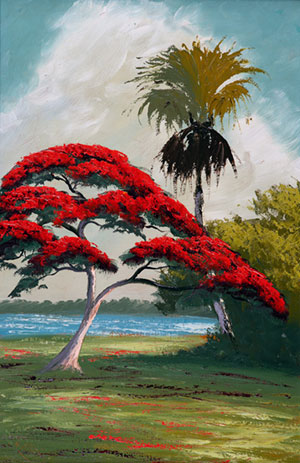
“He had the game plan, the vision and the business sense to monetize his creative talents,” notes Marshall Adams, executive director of the Backus Museum and Gallery. “Undoubtedly, he could have painted slower, but he decided to streamline many aspects of Backus’s paintings. His critical review was whether people bought them or not.”
And buy them they did, so much that Hair hired salesmen to go out on the road for him so that he could spend his time painting.
Much of the Backus exhibition comes from the collection of Highwaymen collector and art dealer Roger Lightle of Vero Beach.
“Of the 26 artists, Alfred Hair was the only one who was a student of Backus,” says Lightle. “Yes, Harold Newton would talk to Backus and ask his advice, but Alfred Hair took painting lessons from him.”
Hair was a student at Lincoln Park Academy when his art teacher, Zanobia Jefferson, recognized a talent she thought should be further nurtured, and she contacted Backus about giving Hair lessons.
So, young Hair crossed the dividing line of the Jim Crow South — the railroad tracks —and made his way to the Backus studio, where he paid 25 cents for lessons from Backus. Sometimes, his sister would clean the house to pay for the lessons.
At the time, in 1958, a young black man taking art lessons from a white man wasn’t widely accepted, but Backus was unconcerned.
“Backus’ studio really was a safe place,” says Adams. “It was a Bohemian bubble where people of all backgrounds could meet. He opened his doors and he lived his life as an example of someone who accepted everyone.”
A fast learner, Hair began learning Backus’s artistic technique that sought to imitate nature.
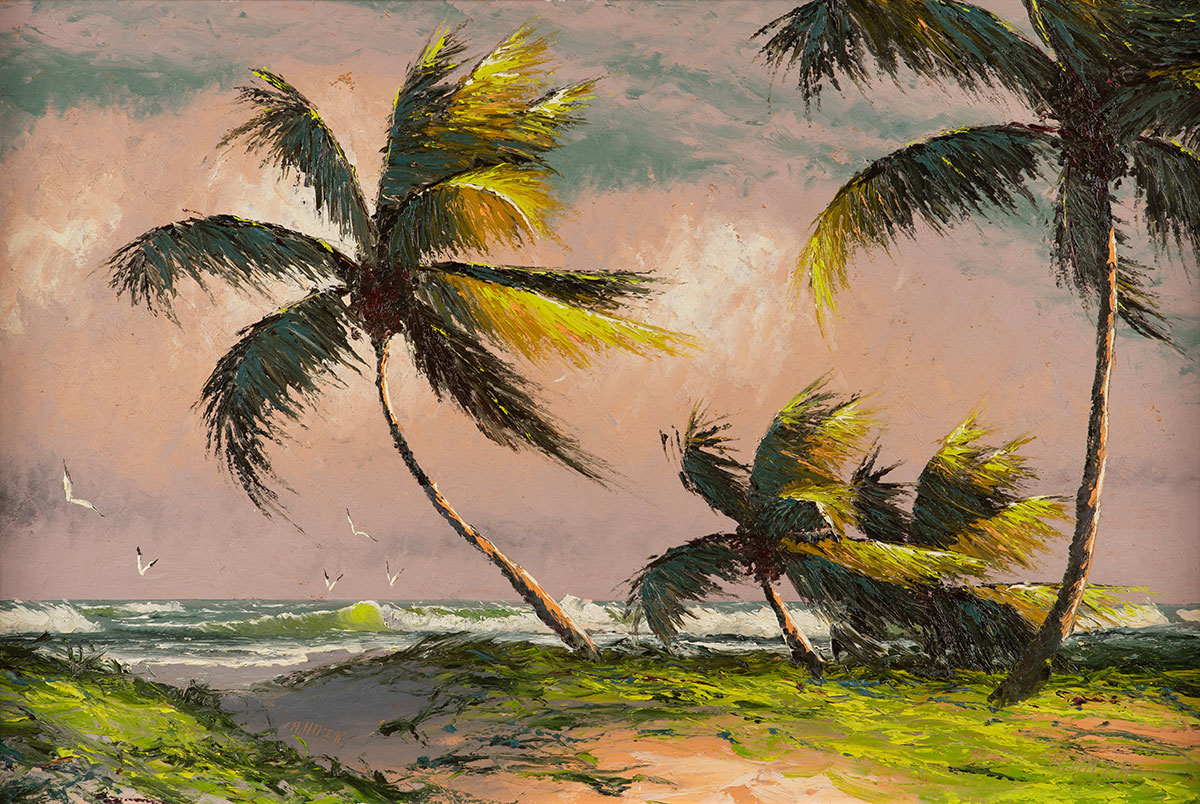
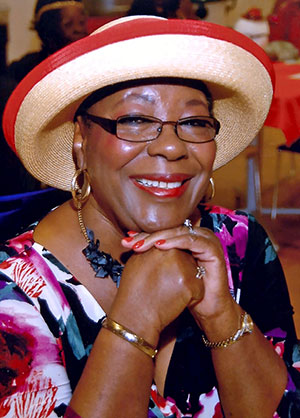
Don D. Brown, also an artist who managed the Backus studio, remembered Hair as a charismatic young man who always had a smile on his face. Hair was quickly involved in life at the studio, making trips to the Bahamas or to Jamaica with Backus and some of the other young people who sought refuge at the studio.
At the time, Backus’ works were so desired that he had a long list of clients willing to wait months for a painting. That fact wasn’t lost on Hair, who decided he could fill the void by painting fast and bringing the paintings to the customers at a better price, $35 to Backus’s $350 or more. With that kind of volume, he could make more money than he ever dreamed. Perhaps, he told others, enough to buy a Cadillac, and maybe even to become a millionaire by the time he was 35.
He started his enterprise in his backyard on Dunbar Street where he lived with Doretha and their children in Fort Pierce. (Earlier paintings have his 13th Street address, where he lived with his mother, stamped on them.) He produced paintings in hours with simple embellishments like his easily recognized “fast grass,” quickly applied strokes of the pallet knife to imitate Florida saw grass.
“Alfred Hair did not copy Backus,” says Lightle. “He took off like a skyrocket. He said he was not going to be bound by the conventions. He took his own path.”
His success didn’t go unnoticed. His best friend, Livingston “Castro” Roberts, was a painter. James Gibson, another friend who went to Lincoln Park Academy with Hair, also began painting and selling. At one time, Willie Daniels and R.L. McLendon, also artists, lived nearby.
Hair did enlist others to paint the backgrounds of his paintings and make his frames in order to keep the production going.

But, Lightle says, Hair’s style was distinctive and most Highwaymen aficionados can recognize an Alfred Hair painting from across the room.
“The color, the technique — no one else paints like him, especially the early ones,” he says.
“You can tell right off the bat,” he says. “It’s the palm trees, one of the trademark images. Another is the bird in flight. You can tell even if it isn’t signed.”
Lightle says there was a story that Harold Newton, who is thought to be among the most gifted of all the artists, said Alfred Hair’s palm trees, top heavy with thatch, looked like they were about to fall over.


Of the thousands of Highwaymen paintings Lightle has seen, he says the most unusual of Hair’s works was a 30-inch by 48-inch painting of a washerwoman, a depiction of a woman hanging up clothes on a clothesline — a simple fact of life in those days, done on a large scale.
“It was capturing true Americana,” he says. “That is the way they lived.”
Hair did get his Cadillac and was well on his way to becoming a millionaire by the time he was killed. Many of the artists kept painting after Hair’s death, some out of desire and others out of necessity.
Doretha remarried and moved to New Jersey. In 2004, she discovered that Hair, his paintings, and the paintings of what were now called the Highwaymen, had been recognized and nominated for the Florida Humanities Artist Hall of Fame. She was able to attend the induction.
“I was extremely happy that Alfred, who gave so much, including his life, was being recognized for his art and humanity,” Truesdell recalls. “Because some of the people that were included as the Highwaymen, he taught.”
Adams says that Hair’s paintings have an energy that represents his vital role in the Highwaymen story.
“He was always looking ahead, and you get that from the paintings, from their intensity.”
Highwaymen Events

A number of events honoring the Florida Highwaymen will take place in January and February in Fort Pierce, where many of the Highwaymen got their start and where many still live.
Highwaymen Art Show
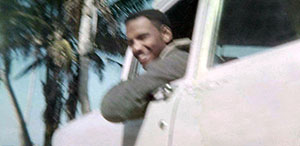
Jetson TV and Appliances will host its popular annual Highwaymen Art Show at its flagship store, 414 S. U.S. 1 in Fort Pierce on Saturday, Jan. 25, from 11 a.m. to 3 p.m.
Owner John Jetson has had a long affiliation with many of the artists and has a large collection of Highwaymen paintings, which will be on display. Although the number of living original Highwaymen inducted into the Florida Artists Hall of Fame has dwindled — most recently with the death of the lone woman in the group, Mary Ann Carroll, in December — many of the remaining Highwaymen, as well as their relatives who have taken on their mantle, will be there selling paintings.
Three Highwaymen paintings, including original oils, will be raffled off.
Susan Harris, who works for Jetson in client relations, was an early admirer of the painters, before they were nicknamed the Highwaymen. When she moved to Vero Beach in the 1990s, she fell in love with the dreamy tropical landscapes she saw in many of the local offices and began looking for the paintings and the artists, befriending all of them.
Calling them all a “treasure,” she says the annual festival is one way she can make good on a promise to Highwaymen Hezekiah Baker and George Buckner before they died.
“They asked me to never let people forget the Highwaymen.”
Harris says that the festival continues to grow in interest and — judging by the number of free hotdogs that are given away — is attended by thousands.
Driving Force: Alfred Hair and the Florida Highwaymen

“Driving Force: Alfred Hair and the Florida Highwaymen” opens at the Backus Museum and Gallery, 500 N. Indian River Drive on Jan. 8 and runs through Feb. 16. Curated by Roger Lightle, the paintings will focus on the art of Alfred Hair, but will include paintings by other Highwaymen, along with A.E. (Bean) Backus.
On Friday, Feb. 14, at 6 p.m., Doretha Hair Truesdell, Alfred Hair’s widow, will speak in the museum, the inaugural event of the Highwaymen weekend.
On Saturday, Feb. 15, and Sunday, Feb. 16, a number of art dealers of Highwaymen works will have vintage paintings for sale on the museum grounds.
Throughout each day, executive director Marshall Adams and Lightle will be giving gallery talks.
Former director Kathleen Fredrick will also be available for appraisals on Saturday and Sunday.
Highwayman Heritage Trail Art Show and Festival

That same weekend, on Feb. 15, from 10 a.m. to 4 p.m., Moore’s Creek Linear Park at the corner of Eighth Street and Avenue D will host Highwaymen who will be selling their own paintings as part of the annual City of Fort Pierce Highwaymen Heritage Trail Art Show and Festival.
It will feature many of the original Highwaymen along with the second generation of artists, free guided Highwaymen Trail tours, local cuisine and kids activities. The event is free, but guided tour seating is limited. Call 772.467.3169.
A free trolley will be available for visitors to go between the Heritage show and the Backus Museum.
